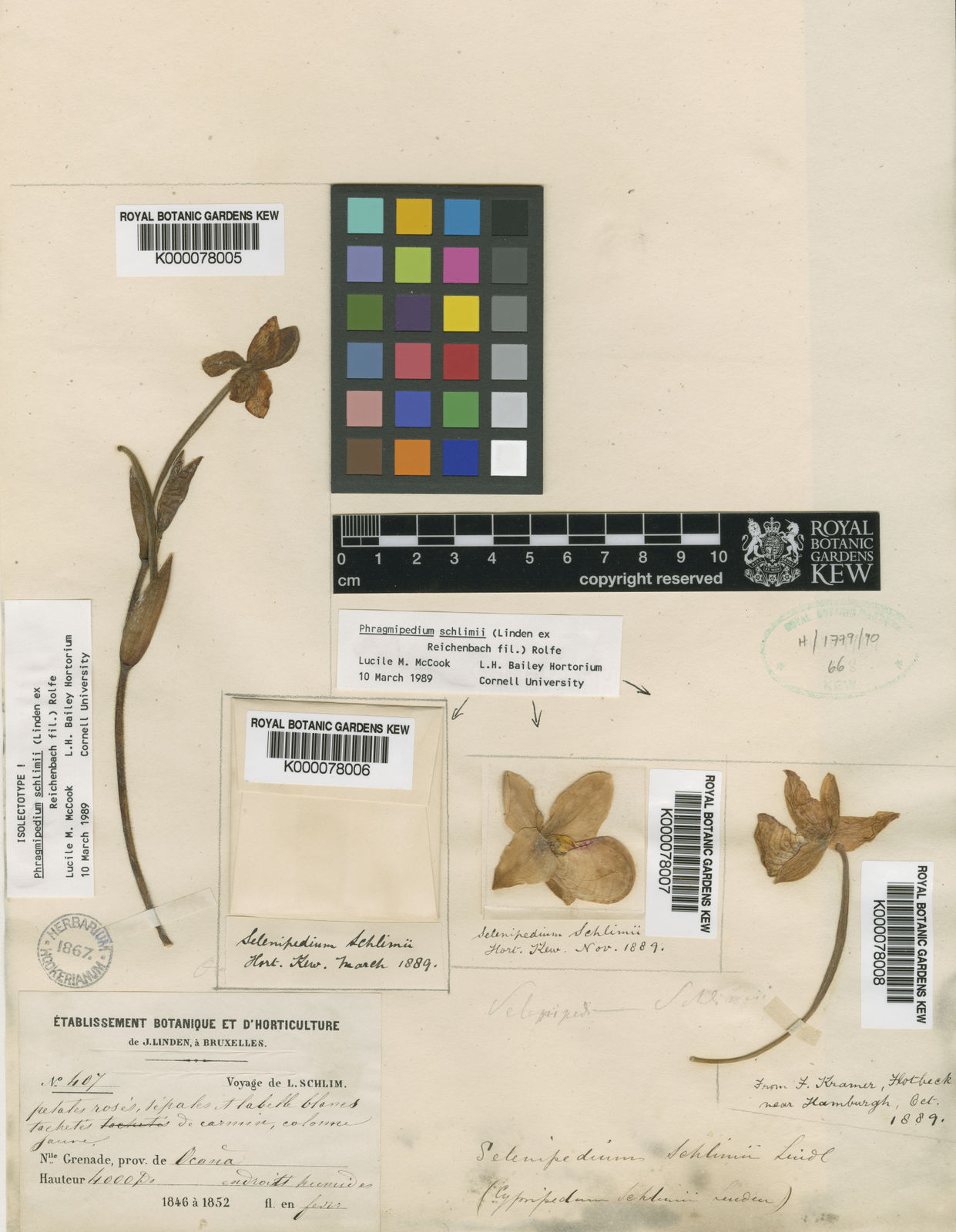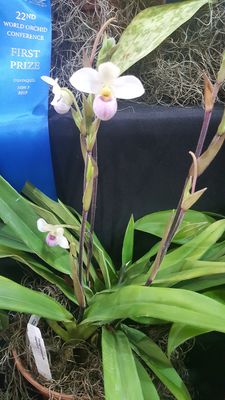Terrestrial herbaceous perennial. Rhizomes to 3 cm long and 1 cm wide. Roots to 0.4 cm in diam, usually striate. Leaves elliptic to lanceolate-ligulate, 4 - 30 cm long, 1.5 - 3.6 cm wide, often widening appreciably 3 - 5 cm from base, thin, glabrous, pale green, often purple basally; margins revolute; apex minutely trifid, oblique, tiny side lobes comprised of marginal tissue and often secondarily lobed. Inflorescence a 1 - 10 flowered spicate raceme or panicle 12 - 27 cm tall. Peduncle purple, sparsely velutinous. Floral bracts ovate-triangular, navicular, 2 - 4 cm long, 1.4 - 2.0 cm wide, shorter than ovary, glabrous, strongly keeled, fused up to 0.6 cm from base on marginal side; margins composed of ranks of perpendicularly elongate cells; apex minutely trifid. Sterile lower bracts 0 - 1, ovate, 3 - 4 cm long, 1.4 cm wide, 6 - 9 cm from plant base; margins similar to basal leaves; apex minutely bifid, oblique. Flower whitish-pink to magenta; outer surfaces mostly pilose-velutinous; inner surfaces mostly glabrous to sparsely pubescent; margins glabrous to ciliate. Dorsal sepal ovate-elliptic, 1.5 - 2.0 cm long, 1.0 - 1.2 cm wide, pink to white infused with pink, 7-nerved; outer surface pilose; margins ciliate; apex acute. Synsepal elliptic, 1.3 - 2.0 cm long, 1 cm wide, smaller than labellum, pink to white infused with pink, not strongly nerved; margins ciliate; apex acute to minutely bifid. Labellum round to slightly pointed, 1.6 - 2.5 cm long, 1.4 cm wide at the widest point, pink to magenta, thin interveinar tissue forming window-like network on sides and back of labellum; labellar opening oval to round, slightly scalloped on apical rim; apical labellum rim dark pink or magenta; apical labellum lining shallow, gently inturned, not sharply folded, often striped with magenta; lateral labellum rim minutely pubescent, spurs absent; lateral labellum lining 0.5 - 0.8 cm wide; claw face white or yellow with pink spots, tubercles absent; claw interior villous, dark red spotted. Petals obovate-rhomboid, 1.5 - 2.4 cm long, 1.1 - 1.4 cm wide, white infused with pink, nerves branching, central nerve prominent, petals held at 90 ͦ from labellum; inner surface sparsely puberulent; basal hairs white, villous-arachnoid; margins ciliate, slightly undulate; apex obtuse. Staminode ovate-pandurate, 0.6 - 1.0 cm long, 0.5 - 0.9 cm wide at apical half, bright yellow with 1-2 reddish-pink apical splotches, central vein often prominent, puberulous; lateral and basal margins often white, finely ciliate; apex acute to shallowly bilobed. Column to 3 mm long, whitish-pink, pilose. Pollinarium 1 - 2 mm wide, anther dark-pigmented. Stigmatic area to 2 mm wide; median lobe conical, to 3 mm long; lateral lobes rounded. Ovary, including pedicel, 5 - 9 cm long, velutinous to hirsute, dark purple. Capsule dark purple-brown, hirsute, splitting in middle; loculicidal vascular strand separating from capsule, beige. Seeds to 1.1 mm long. Chromosome number 2n=30 (Karasawa, 1980).



